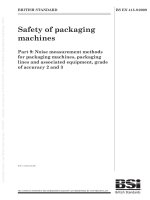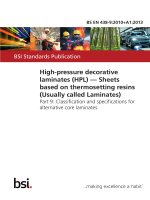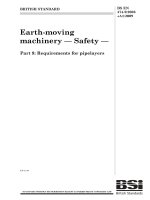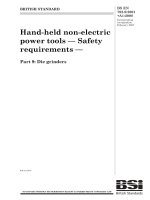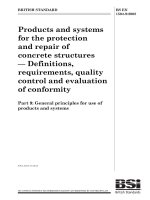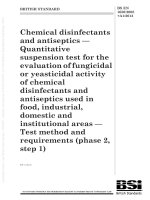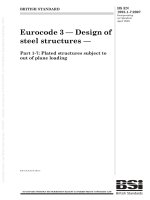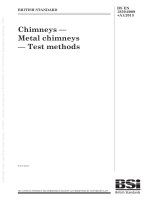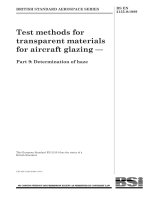Bsi bs en 62056 9 7 2013
Bạn đang xem bản rút gọn của tài liệu. Xem và tải ngay bản đầy đủ của tài liệu tại đây (1.18 MB, 22 trang )
BS EN 62056-9-7:2013
BSI Standards Publication
Electricity metering data
exchange —
The DLMS/COSEM suite
Part 9-7: Communication profile for
TCP-UDP/IP networks
BRITISH STANDARD
BS EN 62056-9-7:2013
National foreword
This British Standard is the UK implementation of EN 62056-9-7:2013. It is
identical to IEC 62056-9-7:2013. It partially supersedes BS EN
62056-53:2007.
The UK participation in its preparation was entrusted to Technical
Committee PEL/13, Electricity Meters.
A list of organizations represented on this committee can be obtained on
request to its secretary.
This publication does not purport to include all the necessary provisions of
a contract. Users are responsible for its correct application.
© The British Standards Institution 2013.
Published by BSI Standards Limited 2013
ISBN 978 0 580 75065 6
ICS 17.220; 35.110; 91.140.50
Compliance with a British Standard cannot confer immunity from
legal obligations.
This British Standard was published under the authority of the
Standards Policy and Strategy Committee on 31 October 2013.
Amendments/corrigenda issued since publication
Date
Text affected
BS EN 62056-9-7:2013
EUROPEAN STANDARD
EN 62056-9-7
NORME EUROPÉENNE
October 2013
EUROPÄISCHE NORM
ICS 17.220; 35.110; 91.140.50
Supersedes EN 62056-53:2007 (partially)
English version
Electricity metering data exchange The DLMS/COSEM suite Part 9-7: Communication profile for TCP-UDP/IP networks
(IEC 62056-9-7:2013)
Échange des données de comptage de
l'électricité La suite DLMS/COSEM Partie 9-7: Profil de communication pour
réseaux TCP-UDP/IP
(CEI 62056-9-7:2013)
Datenkommunikation der elektrischen
Energiemessung - DLMS/COSEM Teil 9-7: Festlegungen zur Nutzung von
TCP-UDP/IP-Netzen
(IEC 62056-9-7:2013)
This European Standard was approved by CENELEC on 2013-05-28. CENELEC members are bound to comply
with the CEN/CENELEC Internal Regulations which stipulate the conditions for giving this European Standard
the status of a national standard without any alteration.
Up-to-date lists and bibliographical references concerning such national standards may be obtained on
application to the CEN-CENELEC Management Centre or to any CENELEC member.
This European Standard exists in three official versions (English, French, German). A version in any other
language made by translation under the responsibility of a CENELEC member into its own language and notified
to the CEN-CENELEC Management Centre has the same status as the official versions.
CENELEC members are the national electrotechnical committees of Austria, Belgium, Bulgaria, Croatia, Cyprus,
the Czech Republic, Denmark, Estonia, Finland, Former Yugoslav Republic of Macedonia, France, Germany,
Greece, Hungary, Iceland, Ireland, Italy, Latvia, Lithuania, Luxembourg, Malta, the Netherlands, Norway, Poland,
Portugal, Romania, Slovakia, Slovenia, Spain, Sweden, Switzerland, Turkey and the United Kingdom.
CENELEC
European Committee for Electrotechnical Standardization
Comité Européen de Normalisation Electrotechnique
Europäisches Komitee für Elektrotechnische Normung
CEN-CENELEC Management Centre: Avenue Marnix 17, B - 1000 Brussels
© 2013 CENELEC -
All rights of exploitation in any form and by any means reserved worldwide for CENELEC members.
Ref. No. EN 62056-9-7:2013 E
BS EN 62056-9-7:2013
EN 62056-9-7:2013
-2-
Foreword
The text of document 13/1520/FDIS, future edition 1 of IEC 62056-9-7, prepared by IEC/TC 13
"Electrical energy measurement, tariff- and load control" was submitted to the IEC-CENELEC parallel
vote and approved by CENELEC as EN 62056-9-7:2013.
The following dates are fixed:
•
latest date by which the document has
to be implemented at national level by
publication of an identical national
standard or by endorsement
(dop)
2014-04-04
•
latest date by which the national
standards conflicting with the
document have to be withdrawn
(dow)
2016-05-28
This document supersedes EN 62056-53:2007 (PART).
EN 62056-9-7:2013 includes the following significant technical changes with respect to EN 6205653:2007:
Note: Whereas IEC 62056-53 Ed. 2.0 contains the specification of the DLMS/COSEM communication profiles, IEC
62056-5-3 Ed.1.0 replacing the earlier edition does not.
• The title of the standard has been aligned with the title of other parts of the revised IEC 62056
series;
• Clause 4, Targeted communication environments has been extended, a functional reference
architecture figure has been added;
• Clause 5, The structure of the profile(s) has been extended, the Figure has been generalized and
simplified;
• In clause 6, Identification and addressing scheme, the port number assigned by the IANA for
DLMS/COSEM has been added;
• In subclause 9.1, Two paragraphs specifying how confirmed and unconfirmed COSEM-OPEN
and xDLMS service invocations have been added;
• Subclause 9.6, Transporting long messages, has been amended. It specifies now that for
transporting long messages, application layer block transfer can be used (also available now with
SN referencing);
• The clause on Multi-drop configurations has been removed.
Attention is drawn to the possibility that some of the elements of this document may be the subject of
patent rights. CENELEC [and/or CEN] shall not be held responsible for identifying any or all such
patent rights.
Endorsement notice
The text of the International Standard IEC 62056-9-7:2013 was approved by CENELEC as a
European Standard without any modification.
In the official version, for Bibliography, the following notes have to be added for the standards
indicated:
1)
1)
IEC 62056-6-1
NOTE
Harmonised as EN 62056-6-1 (not modified).
IEC 62056-6-2
NOTE
Harmonised as EN 62056-6-2 (not modified).
at draft stage.
1)
BS EN 62056-9-7:2013
EN 62056-9-7:2013
-3-
Annex ZA
(normative)
Normative references to international publications
with their corresponding European publications
The following documents, in whole or in part, are normatively referenced in this document and are
indispensable for its application. For dated references, only the edition cited applies. For undated
references, the latest edition of the referenced document (including any amendments) applies.
NOTE When an international publication has been modified by common modifications, indicated by (mod), the relevant EN/HD
applies.
Publication
IEC 62056-5-3
IEC 62056-47
2)
At draft stage.
2)
Year
Title
EN/HD
-
Electricity metering data exchange - The
DLMS/COSEM suite Part 5-3: DLMS/COSEM application layer
EN 62056-5-3
2006
Electricity metering - Data exchange for
meter reading, tariff and load control Part 47: COSEM transport layers for IPv4
networks
EN 62056-47
Year
2)
-
2007
–2–
BS EN 62056-9-7:2013
62056-9-7 © IEC:2013
CONTENTS
1
Scope ............................................................................................................................... 5
2
Normative references ....................................................................................................... 5
3
Terms, definitions and abbreviations ................................................................................ 5
4
3.1 Terms and definitions .............................................................................................. 5
3.2 Abbreviations .......................................................................................................... 5
Targeted communication environments ............................................................................. 6
5
Structure of the profile(s) .................................................................................................. 7
6
Identification and addressing scheme ............................................................................... 8
7
Supporting layer services and service mapping .............................................................. 10
8
Communication profile specific service parameters of the COSEM AL services .............. 11
9
Specific considerations / constraints ............................................................................... 12
9.1 Confirmed and unconfirmed AAs and service invocations, packet types used ........ 12
9.2 Releasing application associations: using RLRQ/RLRE is mandatory .................... 13
9.3 Service parameters of the COSEM-OPEN / -RELEASE / -ABORT services............ 13
9.4 xDLMS client/server type services ......................................................................... 13
9.5 EventNotification Service and TriggerEventNotificationSending service ................. 13
9.6 Transporting long messages .................................................................................. 13
9.7 Allowing COSEM servers to establish the TCP connection .................................... 14
9.8 The COSEM TCP-UDP/IP profile and real-world IP networks ................................. 14
Bibliography .......................................................................................................................... 15
Index .................................................................................................................................... 17
Figure 1 – Communication architecture ................................................................................... 7
Figure 2 – Examples for lower-layer protocols in the TCP-UDP/IP based profile(s) ................. 8
Figure 3 – Identification / addressing scheme in the TCP-UDP/IP based profile(s) ............... 10
Figure 4 – Summary of TCP / UDP layer services ................................................................. 11
Table 1 – Application associations and data exchange in the TCP-UDP/IP based
profile ................................................................................................................................... 12
BS EN 62056-9-7:2013
62056-9-7 © IEC:2013
–5–
ELECTRICITY METERING DATA EXCHANGE –
THE DLMS/COSEM SUITE –
Part 9-7: Communication profile for TCP-UDP/IP networks
1
Scope
This part of IEC 62056 specifies the DLMS/COSEM communication profile for TCP-UDP/IP
networks.
2
Normative references
The following documents, in whole or in part, are normatively referenced in this document and
are indispensable for its application. For dated references, only the edition cited applies. For
undated references, the latest edition of the referenced document (including any
amendments) applies.
IEC 62056-47:2006, Electricity metering – Data exchange for meter reading, tariff and load
control – Part 47: COSEM transport layer for IPv4 networks
IEC 62056-5-3:2013, Electricity metering data exchange – The DLMS/COSEM suite –
Part 5-3: DLMS/COSEM application layer
NOTE
3
See also the Bibliography.
Terms, definitions and abbreviations
For the purposes of this document, the following terms, definitions and abbreviations apply.
3.1
Terms and definitions
3.1.1
client
a station, asking for services. Normally the master station
3.1.2
server
a station, delivering services. The tariff device (meter) is normally the server, delivering the
requested values or executing the requested tasks
3.2
AA
Abbreviations
Application Association
AARE
A-Associate Response – an APDU of the ACSE
AARQ
A-Associate Request – an APDU of the ACSE
ACSE
Association Control Service Element
AL
Application Layer
AP
Application Process
APDU
Application Layer Protocol Data Unit
–6–
ARP
Address Resolution Protocol
ASE
Application Service Element
ATM
Asynchronous Transfer Mode
COSEM
Companion Specification for Energy Metering
DLMS
Device Language Message Specification
FDDI
Fiber Distributed Data Interface
HDLC
High-level Data Link Control
HTTP
Hypertext Transfer Protocol
IEEE
Institute of Electrical and Electronics Engineers
ISO
International Organization for Standardization
IP
Internet Protocol
LN
Local Network
NN
Neighbourhood Network
OSI
Open System Interconnection
PDU
Protocol Data Unit
PhL
Physical Layer
PPP
Point-to-Point Protocol
RLRE
A-Release Response – an APDU of the ACSE
RLRQ
A-Release Request – an APDU of the ACSE
SAP
Service Access Point
TCP
Transmission Control Protocol
TL
Transport Layer
UDP
User Datagram Protocol
WAN
Wide Area Network
xDLMS
Extended DLMS
4
BS EN 62056-9-7:2013
62056-9-7 © IEC:2013
Targeted communication environments
The TCP-UDP/IP based communication profiles are suitable for remote data exchange with
metering equipment via IP enabled networks such as wide area networks, neighbourhood
networks or local networks. This is shown in Figure 1.
BS EN 62056-9-7:2013
62056-9-7 © IEC:2013
–7–
Electricity metering end device
Meter application functions
I
Meter communication functions
G
C
M
Internet enabled
Neighbourhood
Network
Internet enabled
Local Network
L
Local Network Access Point (LNAP)
G
C
Internet enabled
Neighbourhood
Network
N
Neigbourhood Network Access Point (NNAP)
G
Internet enabled WAN
AMI head end system
IEC 688/13
Figure 1 – Communication architecture
5
Structure of the profile(s)
The COSEM TCP-UDP/IP based communication profiles consist of five protocol layers:
•
the DLMS/COSEM application layer, specified in IEC 62056-5-3;
•
the COSEM transport layer, specified in IEC 62056-47;
•
a network layer: the Internet protocol: IPv4, specified in STD 0005 or IPv6 specified in
RFC 2460;
•
a data link layer: any data link protocol supporting the network layer;
•
a physical layer: any PhL supported by the data link layer chosen.
The COSEM AL uses the services of one of the TLs (TCP or UDP) via a wrapper, which, in
their turn, use the services of the IP network layer to communicate with other nodes
connected to this abstract network. The COSEM AL in this environment can be considered as
another Internet standard application protocol, which may co-exist with other Internet
application protocols, like FTP, HTTP, etc. See IEC 62056-47:2006, Figure 1.
BS EN 62056-9-7:2013
62056-9-7 © IEC:2013
–8–
The TCP-UDP/IP layers are implemented on a wide variety of real networks, which, just with
the help of this IP Network abstraction, can be seamlessly interconnected to form Intra- and
Internets using any set of lower layers supporting the Internet Protocol.
COSEM Application process
Application
Messaging
Files
FTP
Web pages
COSEM interface classes
OBIS object identification
DLMS/COSEM application
layer
xDLMS messaging services
ACSE services
HTTP
TCP
conncetion
manager
Wrapper
TCP-UDP transport layer protocol
Transport
IP network layer protocol
Network
Convergence/
Adaptation
Data Link
MAC + LLC
Wide Area Network
lower layer protocols
GPRS
GSM
PSTN
Neighbourhood
Network
lower layer protocols
PLC
Wireless
Local Network
lower layer protocols
PLC
Wireless
Wired
Physical
IEC 689/13
Figure 2 – Examples for lower-layer protocols in the TCP-UDP/IP based profile(s)
Below the IP layer, a range of lower layers can be used. One of the reasons of the success of
the Internet protocols is just their federating force. Practically any data networks, including
Wide Area Networks such as GPRS, ISDN, ATM and Frame Relay, circuit switched PSTN and
GSM networks (dial-up IP), Local Area Networks, such as Ethernet, neighbourhood networks
and local networks using power line carrier or wireless protocols, etc., support TCP-UDP/IP
networking.
Figure 2 shows a set of examples – far from being complete – for such communication
networks and for the lower layer protocols used in these networks. Using the TCP-UDP/IP
profile, DLMS/COSEM can be used practically on any existing communication network.
6
Identification and addressing scheme
Although real-world devices even in the Internet environment are connected to real-world
physical networks, at a higher abstraction (and protocol) level it can be considered as if these
devices would be connected to a virtual – IP – network. On this virtual network, each device
has a unique address, called IP address, which non-ambiguously identifies the device on this
network.
BS EN 62056-9-7:2013
62056-9-7 © IEC:2013
–9–
Any device connected to this virtual IP network can send message(s) to any other connected
device(s) using only the IP address to designate the destination device, without being
concerned about the complexity of the whole physical network. Specific characteristics – the
data transmission medium, the media access strategy, and the specific data-link addressing /
identification scheme – of the particular physical network(s) participating in the route between
the source and the destination device are hidden for the sender device. These elements are
handled by intermediate network devices, called routers.
Therefore, in the TCP-UDP/IP based profiles COSEM physical devices are non-ambiguously
identified by their network – IP – address.
The identification of COSEM client AP and server APs requires an additional address.
Both TCP and UDP provide additional addressing capability at the transport level, called port,
to distinguish between applications. The AL is listening only on one TCP or UDP port for
exchanging messages between any client and server APs. As in a single physical device
several client or server APs may be present, an additional addressing capability is needed.
This is provided by the wrapper sublayer, see IEC 62056-47. The wrapper provides an
identifier – wPort – similar to the TCP or UDP port numbers, but on the top of these layers. A
particular COSEM client AP and/or a particular COSEM logical device in the same physical
device can be thus identified by its wPort number.
In summary, in the TCP-UDP/IP based profiles the following identification rules apply:
•
COSEM physical devices are identified by their IP address;
•
the COSEM AL is listening only on one UDP or TCP port. See IEC 62056-47:2006, Clause
4;
•
COSEM logical devices and client APs within their respective host physical devices are
identified by their wPort numbers. Reserved wPort numbers are specified in IEC 62056-47;
•
lower layer addresses (SAP-s) are not considered (hidden).
COSEM AAs are identified by the identifiers of the two end-points as described above.
Figure 3 shows an example.
AAs established between the client AP_01 and Logical_Device_01 in Host_device_01 (AA 1)
and Logical_Device_02 in Host_Device_02 (AA2) respectively are identified by:
AA 1:
{ ( 163.187.45.19, T_N, 31 ) ( 163.187.45.36, T_M, 527 ) }
AA 2:
{ ( 163.187.45.19, T_N, 31 ) ( 163.187.45.78, T_M, 3013 ) }
NOTE 1 T_N and T_M mean the TCP port used for DLMS/COSEM in the client host device and the server host
devices respectively. For DLMS/COSEM, the following port numbers have been registered by the IANA. See
/>•
dlms/cosem 4059/TCP DLMS/COSEM
•
dlms/cosem 4059/UDP DLMS/COSEM
NOTE 2 In these two AAs the client side end-point identifiers are the same. However, the server side end-point
identifiers are different, so the two AAs are identified unambiguously and therefore they can be used
simultaneously.
NOTE 3
In these examples, IPv4 addresses are used.
BS EN 62056-9-7:2013
62056-9-7 © IEC:2013
– 10 –
COSEM
Application
Processes
and the
COSEM
Application
Layer
Host device for Clients
COSEM
Client
_AP_02
COSEM
Client
_AP_01
31
N
N
UDP
Server_01
Protocol
Layers of the
TCP-UDP/IP
profile
163.187.45.19
Server_02
(COSEM
Logical _
Device_01)
527 3013
31
Wrapper
TCP
Host_device_01 for Servers
(COSEM
Logical_
Device_02)
527 3013
Wrapper
M
TCP
Host_device_02 for Servers
Server_
01
(COSEM
Logical _
Device_01)
527
163.187.45.36
(COSEM
Logical _
Device_03)
(COSEM
Logical _
Device_02)
3013 3014
M
UDP
Server_
_03
Server_
_02
527 3013 3014
Wrapper
M
TCP
M
UDP
163.187.45.78
IP
IP
IP
Data Link Layer
Data Link Layer
Data Link Layer
Physical Layer
Physical Layer
Physical Layer
Network
IEC 690/13
Figure 3 – Identification / addressing scheme
in the TCP-UDP/IP based profile(s)
7
Supporting layer services and service mapping
As specified in IEC 62056-47, the COSEM TCP TL provides the following services to its
service users:
•
•
Connection management services, provided for the TCP connection manager AP:
–
TCP-CONNECT:
.request, .indication, .response, .confirm;
–
TCP-DISCONNECT: .request, .indication, .response, .confirm.
Data exchange services, provided for the COSEM AL; these services can be used only
when the TCP connection is established:
–
TCP-DATA:
.request, .indication, (. confirm).
The TCP TL also provides a TCP-ABORT service to the service user COSEM AL to indicate
the disconnection/disruption of the TCP layer connection.
The UDP TL provides only one service to the service user COSEM AL: a connection-less,
best effort data delivery service.
•
NOTE
UDP-DATA:
request, .indication, (.confirm).
A TCP.confirm / UDP .confirm service primitive is optionally available.
Figure 4 summarizes these services.
BS EN 62056-9-7:2013
62056-9-7 © IEC:2013
– 11 –
COSEM Application Process
TCP-DISCONNECT.cnf / .ind
UDP-DATA.ind
UDP-DATA.cnf
UDP-DATA.req
TCP-DATA.ind
TCP-DATA.cnf
TCP-DATA.req
DLMS/COSEM Application Layer
TCP-ABORT.ind
TCP-DISCONNECT.req / .res
TCP-CONNECT.cnf / .ind
TCP-CONNECT.req / .res
TCP Connection
Manager
COSEM TCP - UDP/IP transport layers
IEC 691/13
Figure 4 – Summary of TCP / UDP layer services
For connection management, the COSEM TCP TL provides the full set of the TCP-CONNECT
and TCP-DISCONNECT services, both at the client and at the server sides. The purpose of
this is to allow also the server to establish and release TCP connections. See also 9.7. As in
all COSEM profiles, AA establishment and release is initiated by the client AP in these
profiles as well.
The user of these services is not the COSEM AL, but the TCP Connection Manager AP. This
process is implementation dependent, therefore it is out of the scope of this standard. The
only requirements with regard to this process are:
•
the TCP connection manager process shall be able to establish the supporting TCP
connection without the intervention of the COSEM client- or server AP(s);
•
the COSEM client- and server APs shall be able to retrieve the TCP and IP portion of the
Protocol_Connection_Parameters parameter from the TCP connection manager before
sending / receiving a COSEM-OPEN.request / .indication.
For data exchange, both the client- and the server ALs use the complete set of the service
primitives provided by the COSEM TCP-UDP TLs.
The correspondence between an AL (ASO) service invocation and the supporting COSEM
TCP-UDP layer service invocation is given in IEC 62056-47.
8
Communication profile specific service parameters of the COSEM AL
services
Only the COSEM-OPEN service has communication profile specific parameters, the
Protocol_Connection_Parameters parameter. This contains the following data:
•
Protocol (Profile) Identifier
TCP/IP or UDP/IP;
•
Server_IP_Address
COSEM Physical Device Address;
BS EN 62056-9-7:2013
62056-9-7 â IEC:2013
12
ã
Server_TCP_or_UDP_Port
The TCP or UDP port used for DLMS/COSEM;
•
Server_wrapper_Port
COSEM Logical Device Address;
•
Client_IP_Address
COSEM Client’s Physical Device Address;
•
Client_TCP_or_UDP_Port,
The TCP or UDP port used for DLMS/COSEM;
•
Client_wrapper_Port
COSEM application process (type) identifier.
Any server address parameter may contain special addresses (All-station, No-station, etc.).
For more information, see IEC 62056-47.
9
Specific considerations / constraints
9.1
Confirmed and unconfirmed AAs and service invocations, packet types used
Table 1 shows the rules for establishing confirmed and unconfirmed AAs, the type of data
transfer services available in such AAs and the TL packet types used for carrying APDU-s. In
this table, grey areas represent cases, which are out of the normal operating conditions:
either not allowed or have no useful purpose.
According to this:
•
it is not allowed to establish an unconfirmed AA using the TCP/IP protocol. It is prevented
by the Client AL, which locally and negatively confirms COSEM-OPEN.request primitive
invocations trying to do that;
•
it is not allowed to request an xDLMS service in a confirmed way (Service_Class =
Confirmed) within an unconfirmed AA, established on the top of the UDP layer. This is
also prevented by the Client AL. Servers, receiving such APDUs shall simply discard
them, or, shall send back a ConfirmedServiceError APDU or, if the feature is
implemented, send back the optional ExceptionResponse APDU.
Table 1 – Application associations and data exchange
in the TCP-UDP/IP based profile
Application association establishment
Protocol
connection
parameters
COSEM-OPEN
service class
Use
Data exchange
Type of
established
application
association
1/ Connect TCP
layer
Id: TCP/IP
Confirmed
TCP port
numbers,
IP addresses
Unconfirmed
Id: UDP/IP
UDP port
numbers,
IP addresses
Confirmed
Unconfirmed
2/ Exchange
AARQ/AARE
APDU-s
transported in
TCP packets
Local negative
confirmation
Exchange
AARQ/AARE
APDU-s
transported in
UDP datagrams
Send AARQ in
a UDP
datagram
Service class
Use
Confirmed
TCP packet
Unconfirmed
TCP packet
-
-
-
-
Confirmed
UDP datagram
Unconfirmed
UDP datagram
Confirmed
(not allowed)
-
Unconfirmed
UDP datagram
Confirmed
None
Confirmed
Unconfirmed
BS EN 62056-9-7:2013
62056-9-7 © IEC:2013
– 13 –
In the TCP-UDP/IP based profiles, the Service_Class parameter of the COSEM-OPEN service
is linked to the response-allowed parameter of the xDLMS InitiateRequest APDU. If the
COSEM-OPEN service is invoked with Service_Class == Confirmed, the response-allowed
parameter shall be set to TRUE. The server is expected to respond. If it is invoked with
Service_Class == Unconfirmed, the response-allowed parameter shall be set to FALSE. The
server shall not send back a response.
The Service_Class parameter of the GET, SET and ACTION services is linked to the
confirmed/unconfirmed bit of the Invoke-Id-And-Priority byte. If the service is invoked with
Service_Class = Confirmed, the confirmed/unconfirmed bit shall be set to 1, otherwise it shall
be set to 0.
9.2
Releasing application associations: using RLRQ/RLRE is mandatory
In the TCP-UDP/IP based profile, using the A-RELEASE services of the ACSE – by invoking
the COSEM-Release.request primitive with Use_RLRQ_RE == TRUE – is mandatory for the
following reasons:
•
according to the identification / addressing scheme used in this profile, an AA is identified
by two triplets, including the IP Address, the TCP (or UDP) port number and the wPort
number. In other words, all AAs within this profile are established using only one TCP (or
UDP) port. This means, that disconnecting the TCP connection (this way of releasing AA
shall also be supported) would release all AAs established. Using the RLRQ/RLRE APDUs allows to release confirmed AAs in a selective way;
•
it is allowed to establish both confirmed and unconfirmed AAs on the connectionless UDP
TL. The only way to release such associations is the use of the RLRQ/RLRE services.
NOTE In fact, using the RLRQ/RLRE APDU-s is specified as optional only to keep backward compatibility with
earlier versions of the specification, which did not include this possibility.
9.3
Service parameters of the COSEM-OPEN / -RELEASE / -ABORT services
The optional User_Information parameters of the COSEM-OPEN / -RELEASE services are not
supported in this communication profile.
9.4
xDLMS client/server type services
No specific features / constraints apply related to the use of client/server type services.
9.5
EventNotification Service and TriggerEventNotificationSending service
This subclause describes the communication profile specific elements of the protocol of the
EventNotification service, see IEC 62056-5-3:2012, 6.9.
As in this profile both the TCP and UDP profile allow sending data in an unsolicited manner,
the Trigger_EventNotification_Sending service is not used.
The EventNotificationRequest APDU may be sent either using the connectionless data
services of the COSEM UDP-based TL or by the connection-oriented data services of the
COSEM TCP-based TL. In this latter case, a TCP connection has to be built first by the TCP
Connection Manager process.
The
optional
Application_Addresses
parameter
is
present
only
EventNotification.request service is invoked outside of an established AA.
9.6
when
the
Transporting long messages
The data field of the wrapper layer shall always carry a complete xDLMS APDU.
message is long, then application layer block transfer can be used.
If the
– 14 –
9.7
BS EN 62056-9-7:2013
62056-9-7 © IEC:2013
Allowing COSEM servers to establish the TCP connection
In DLMS/COSEM, supporting layer connections are generally established during AA
establishment following the invocation of the COSEM-OPEN.request primitive by the client AP
(the PhL connection shall be already established before invoking the COSEM-OPEN.request
primitive). Therefore linking the process of establishing an AA and connecting the supporting
layer is just natural.
However, in some cases it would be useful if the server could also initiate the connection of
the TCP layer. This is particularly interesting in the TCP-UDP/IP based profile, when the
server does not have a public IP address. In this case, as the client does not “see” the
physical device hosting the server(s), it is not able to establish the required TCP layer
connection.
In order to allow the server to establish the TCP layer connection, the full set of service
primitives of the TCP-CONNECT service is available both on the client and the server side.
NOTE
These services are used by the TCP connection manager, not by the AL.
9.8
The COSEM TCP-UDP/IP profile and real-world IP networks
IEC 62056-47, IEC 62056-5-3:2013 and this standard specify all DLMS/COSEM-specific
elements necessary to use DLMS/COSEM over the Internet, using the TCP-UDP/IP based
communication profile.
On real Internet networks, there are other elements, which need to be considered. For
example, in this standard it is specified, that physical devices hosting COSEM APs are
identified with an IP address, but it is not specified, how to obtain such an IP address. As
these elements are not specific to COSEM, they are not in the scope of this international
standard.
BS EN 62056-9-7:2013
62056-9-7 © IEC:2013
– 15 –
Bibliography
DLMS UA 1000-1 Ed. 10.0:2010, COSEM Identification System and Interface Classes the
“Blue Book”
DLMS UA 1000-2 Ed. 7.0:2009, DLMS/COSEM Architecture and Protocols, the "Green Book"
DLMS UA 1001-1 Ed. 4.0:2010, DLMS/COSEM Conformance Test and certification process,
the "Yellow Book"
IEC 60050-300:2001, International Electrotechnical Vocabulary
electronic measurements and measuring instruments
(IEV)
– Electrical and
IEC 62051:1999, Electricity metering – Glossary of terms
IEC 62051-1:2004, Electricity metering – Data exchange for meter reading, tariff and load
control – Glossary of terms – Part 1: Terms related to data exchange with metering equipment
using DLMS/COSEM
IEC 62056-6-1:2013, Electricity metering data exchange – The DLMS/COSEM suite – Part 61: OBIS Object identification system
IEC 62056-6-2:2013, Electricity metering data exchange – The DLMS/COSEM suite – Part 62: COSEM interface classes
ISO/IEC 7498-1:1994, Information technology – Open Systems Interconnection – Basic
Reference Model: The Basic Model
ISO/IEC 9545:1994, Information technology – Open Systems Interconnection – Application
Layer structure
Internet Engineering Task Force (IETF) RFC 0768: User Datagram Protocol. Author: J. Postel.
Date: Aug-28-1980. Also: STD0006 Available from: />Internet Engineering Task Force (IETF) RFC 0791: Internet Protocol. Author: J. Postel. Date:
Sep-01-1981. Also: STD0005. Available from: />Internet Engineering Task Force (IETF) RFC 0792: Internet Control Message Protocol Author:
J. Postel. Date: Sep-01-1981. Also: IETF STD 0005. Updated by: RFC 0950, Obsoletes: RFC
0777. Available from: />Internet Engineering Task Force (IETF) RFC 0793: Transmission Control Protocol. Author: J.
Postel. Date: Sep-01-1981 Also: STD0007.
Available from: />Internet Engineering Task Force (IETF) RFC 1661 – The Point-to-Point Protocol (PPP)
Authors: W. Simpson, Ed. Date: July 1994
Also: STD0051 Available from: />Internet Engineering Task Force (IETF) RFC 2225 – Classical IP and ARP over ATM. Authors:
M. Laubach, J. Halpern. Date: April 1998. Available from: />Internet Engineering Task Force (IETF) RFC 2460: Internet Protocol, Version 6 (IPv6) Edited
by S. Deering and R. Hinden. December 1998.
Available from: />
– 16 –
BS EN 62056-9-7:2013
62056-9-7 © IEC:2013
Internet Engineering Task Force (IETF) RFC 4944: Transmission of IPv6 Packets over IEEE
802.15.4 Networks. Edited by G. Montenegro, N. Kushalnagar and D. Culler. September
2007. Available from: />
BS EN 62056-9-7:2013
62056-9-7 © IEC:2013
– 17 –
Index
AA establishment, 13
AA release, 13
Application layer, 9
A-RELEASE service, 15
Block transfer, 16
Confirmed AA, 14
Confirmed/unconfirmed bit, 15
Connection management services, 13
COSEM client, 11
COSEM logical device, 11
COSEM physical device, 11
COSEM server, 11
COSEM-OPEN.request, 16
Data exchange services, 13
Data link layer, 9
Ethernet, 10
EventNotification service, TCP-UDP/IP based profile, 16
GPRS, 10
Invoke-Id-And-Priority, 15
IP address, 11
IP enabled network, 8
IPv4 address, 12
Local Network, 10
Neighbourhood Network, 10
Network Layer, 9
Physical layer, 9
Port, 11
Port number, 15
Protocol_Connection_Parameters, 14
Public IP address, 16
Real-world IP networks, 16
Response-allowed, 15
Service_Class, 15
TCP connection establishment, 13, 16
TCP Connection Manager, 13
Transport layer, 9
Transporting long messages, TCP-UDP/IP based profile,
16
Trigger_EventNotification_Sending service, 16
TriggerEventNotificationSending, 16
Unconfirmed AA, 14
Wide Area Network, 8, 10
Wireless protocols, 10
wPort, 11
wPort number, 15
Wrapper, 9
Wrapper sublayer, 11
_____________
This page deliberately left blank
This page deliberately left blank
NO COPYING WITHOUT BSI PERMISSION EXCEPT AS PERMITTED BY COPYRIGHT LAW
British Standards Institution (BSI)
BSI is the national body responsible for preparing British Standards and other
standards-related publications, information and services.
BSI is incorporated by Royal Charter. British Standards and other standardization
products are published by BSI Standards Limited.
About us
Revisions
We bring together business, industry, government, consumers, innovators
and others to shape their combined experience and expertise into standards
-based solutions.
Our British Standards and other publications are updated by amendment or revision.
The knowledge embodied in our standards has been carefully assembled in
a dependable format and refined through our open consultation process.
Organizations of all sizes and across all sectors choose standards to help
them achieve their goals.
Information on standards
We can provide you with the knowledge that your organization needs
to succeed. Find out more about British Standards by visiting our website at
bsigroup.com/standards or contacting our Customer Services team or
Knowledge Centre.
Buying standards
You can buy and download PDF versions of BSI publications, including British
and adopted European and international standards, through our website at
bsigroup.com/shop, where hard copies can also be purchased.
If you need international and foreign standards from other Standards Development
Organizations, hard copies can be ordered from our Customer Services team.
Subscriptions
Our range of subscription services are designed to make using standards
easier for you. For further information on our subscription products go to
bsigroup.com/subscriptions.
With British Standards Online (BSOL) you’ll have instant access to over 55,000
British and adopted European and international standards from your desktop.
It’s available 24/7 and is refreshed daily so you’ll always be up to date.
You can keep in touch with standards developments and receive substantial
discounts on the purchase price of standards, both in single copy and subscription
format, by becoming a BSI Subscribing Member.
PLUS is an updating service exclusive to BSI Subscribing Members. You will
automatically receive the latest hard copy of your standards when they’re
revised or replaced.
To find out more about becoming a BSI Subscribing Member and the benefits
of membership, please visit bsigroup.com/shop.
With a Multi-User Network Licence (MUNL) you are able to host standards
publications on your intranet. Licences can cover as few or as many users as you
wish. With updates supplied as soon as they’re available, you can be sure your
documentation is current. For further information, email
BSI Group Headquarters
389 Chiswick High Road London W4 4AL UK
We continually improve the quality of our products and services to benefit your
business. If you find an inaccuracy or ambiguity within a British Standard or other
BSI publication please inform the Knowledge Centre.
Copyright
All the data, software and documentation set out in all British Standards and
other BSI publications are the property of and copyrighted by BSI, or some person
or entity that owns copyright in the information used (such as the international
standardization bodies) and has formally licensed such information to BSI for
commercial publication and use. Except as permitted under the Copyright, Designs
and Patents Act 1988 no extract may be reproduced, stored in a retrieval system
or transmitted in any form or by any means – electronic, photocopying, recording
or otherwise – without prior written permission from BSI. Details and advice can
be obtained from the Copyright & Licensing Department.
Useful Contacts:
Customer Services
Tel: +44 845 086 9001
Email (orders):
Email (enquiries):
Subscriptions
Tel: +44 845 086 9001
Email:
Knowledge Centre
Tel: +44 20 8996 7004
Email:
Copyright & Licensing
Tel: +44 20 8996 7070
Email:
